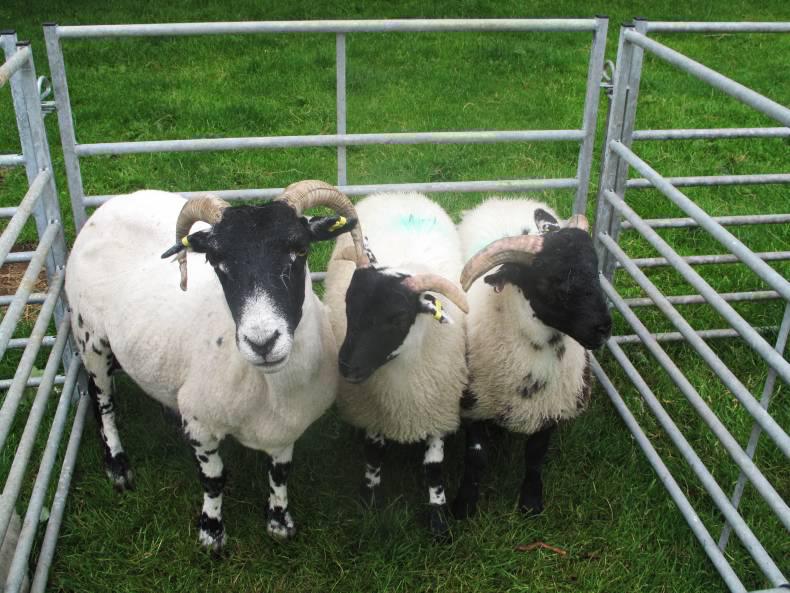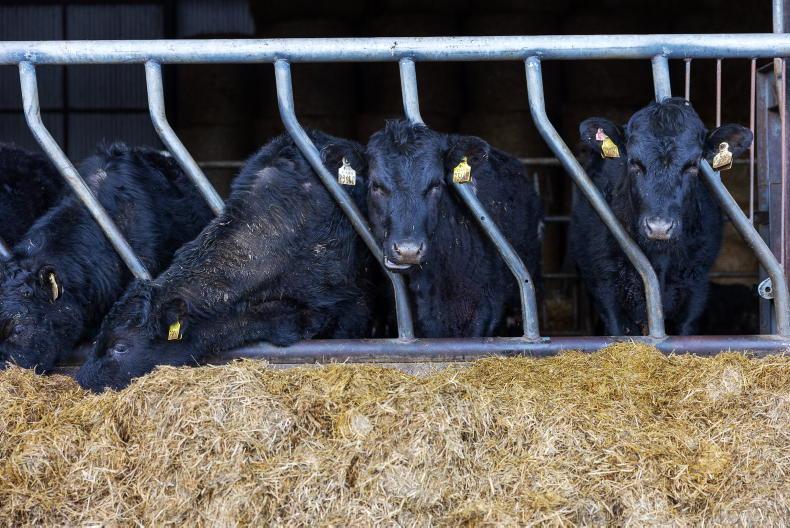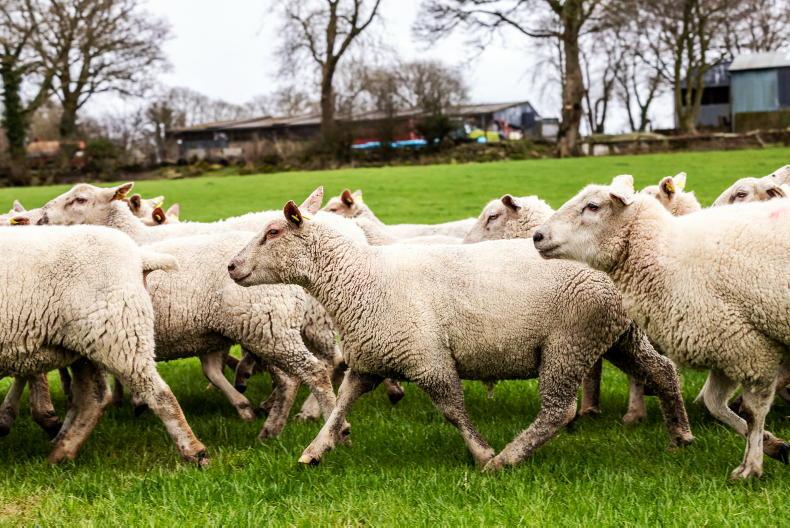There has been a significant volume of research on breeding programmes carried out in Northern Ireland in recent years by CAFRE and AFBI and through AgriSearch on-farm research.
The research has focused on increasing flock output and efficiency, while taking into account how changes to breeding programmes affect other aspects of the farm, with a particular emphasis in hill flocks on the breed’s suitability to its grazing environment.
Last week’s NSA SheepNI 2015 event organised by the northern region of the National Sheep Association (NSA) included the option of visits to CAFRE Glenwherry Hill Farm. The farm extends to 960ha (2,372 acres) and, given its diverse topography and land type, is an ideal setting to trial different breeding programmes.
Only 5% of the farm is classified as improved grassland, which is essentially better-quality grazing areas where silage could be harvested. Forty-eight per cent is unimproved grassland which is a mixture of permanent grasses, wild grasses and vegetation such as rushes. The remaining 47% is classified as heather moorland, which is a mixture of rough moorland grazing and blanket bog. The farm’s elevation above sea level ranges from about 200m to 390m.
Stock numbers
The farm runs mixed sheep and suckler enterprises. The herd comprises 100 suckler cows with male progeny and heifers not selected as replacements transferred to the Greenmount Abbey farm for finishing.
There are normally 1,100 ewes run across a number of systems although numbers are approximately 1,050 at the moment. The farm is still recovering after the heavy snowfalls in March 2013 killed over 100 ewes and hoggets and reduced the number of progeny available for retention.
Breeding programme
The breeding programme is summarised visually in Figure 1 above. The hill flocks comprise a flock of 240 Scottish Blackface ewes, which are bred pure. Replacements from this flock go towards maintaining the flock and also to a flock of 80 pure Scottish Blackface ewes that are joined to a Swaledale ram. Explaining the reasoning behind the Blackface x Swaledale flock, Albert Johnston of CAFRE said: “We are not saying that the Blackface x Swaledale cross is any better than the pure breed, but the cross introduces hybrid vigour to the mix. This has benefits in better fertility, faster growth rates and hopefully longevity which we are monitoring.”
Blackface ewe lambs for both of these flocks are selected using Signet recording data, which the farm contributes to and utilises evaluations.
Female progeny from the Blackface x Swaledale are maintained in a flock of 230 ewes, which are run mainly in an upland area. These ewes are bred to a Texel ram, selected with good estimated breeding values (EBVs) for growth rate, maternal characteristics and conformation.
Albert says that female progeny from this mix have proven to be high-quality replacements, while Texel genetics in the cross increase the value of male progeny, with better growth characteristics and terminal traits.
Texel progeny from the Blackface x Swaledale breed cross form the basis of the largest flock of 500 ewes on the farm. From this flock, 350 ewes are mated to a Primera ram, with the remaining 150 ewes joined to Lleyn rams. All Primera-sired progeny are slaughtered, while female Lleyn cross ewe lambs are selected as replacements for CAFRE’s lowland sheep flock at the Abbey Farm in Greenmount.
Flock performance
Performance of the flocks is positive. Table 1 summarises ewe liveweight at mating and lambing performance per ewe joined. Albert says that the barren rate in Blackface flocks is about 8% to 9% and it is an area being focused on in a bid to reduce this figure further. The average barren rate across both flocks is 6% or 986 ewes scanned out of 1,047 put to the ram. Scottish Blackface ewes all lamb outdoors, irrespective of weather conditions, which serves to increase losses. At eight weeks post-lambing, there are 910 ewes rearing 1,480 lambs or an average of over 1.6 lambs per ewe rearing.
It is early days to assess lamb performance for 2015, but lamb performance for 2014 is detailed in Table 2. The boost in performance from hybrid vigour is evident in daily liveweight gain of Swaledale-sired progeny.
There is very little separating performance of the Texel, Lleyn and Primera-sired progeny with better terminal growth characteristics of Texel and Primera giving it the edge over Lleyn progeny. The same can be said of post-weaning performance.
Selecting replacements
All lambs are tagged at birth to allow performance of lambs and their ewes to be monitored accurately. As mentioned above, Blackface replacements are selected on Signet recording data. Swaledale x Blackface replacement ewe lambs and crossbred ewe lambs are selected using the AFBI management recording system. Ewe lambs that achieve a growth rate of over 250g per day from birth to weaning and born as a twin or triplet are selected.
Hoggets
All replacements are mated as hoggets as the hill farm is unsuitable for lambing sheep as yearlings. Albert says that the Lleyn-sired ewe lambs are performing excellently in the Abbey Farm, with the 2014 scanning rate recorded at 2.1% per ewe mated.
The ewe hoggets also have a lower mature liveweight, which is linked to lower intake and maintenance requirements.
Rams are selected on a combination of physical correctness and their EBVs. Selection of the hill breeds is balanced on maternal and terminal traits, with hardiness and good mothering ability a key component for lambing in harsh terrain.
Texel and Lleyn sires are also selected with a primary focus on maternal qualities. Rams must possess favourable, but not excessive, terminal traits.
The Primera is a relatively new breed in Northern Ireland. It is a composite terminal breed (Suffolk, White Suffolk and Polled Dorset genetics) developed in New Zealand with one attribute of higher fat cover, which Albert says is a benefit for finishing lambs off grass without the need for supplementation.
Incidentally, the Highlander cross trialled in the same manner as the Texel cross has been discontinued, with the cross seen as unsuitable in tougher grazing conditions due to a poorer ability to maintain body condition, which may also be linked to higher prolificacy of the breed.
Presentations from CAFRE’s sheep technologist Eileen McCloskey (pictured below) relating to selecting the most suitable breed to suit hill land type have been featured previously on the sheep pages.
At the Glenwherry farm visit, Eileen gave an update on ongoing research. She said that, in hill enterprises, the goal is to select ewes that are fit to manage in their habitat and perform without the need for excessive feed supplementation.
While this is critical to enterprise output and profitability, Eileen added that a factor which also needs to be taken into account is habitat management. This is because maintaining hills in good agricultural and environmental condition (GAEC) is a key aspect of a farmer receiving their Basic Payment Scheme and avoiding penalties related to land eligibility.
From the research carried out, she noted that most breeds graze available green grass first but, once this is consumed, there are significant differences in a breed’s grazing habits and the type of vegetation consumed. For example, Scottish Blackface and Swaledale breeds are better foragers by their nature and will cover more ground from the outset and consume more variable vegetation than typical lowland breed crosses. This is demonstrated in Tables 3 and 4 and Figure 2.
The Blackface sheep covered 0.69km/day more than the Texel x Blackface cross ewes as shown in Table 3 but when you look at Figure 2, you can quickly see that the extra area was over a far larger terrain demonstrated by the yellow dots. The hill breeds also consume a far higher percentage of heather and rush as detailed in Table 4.
On the production side, previous research has shown benefits in output and lamb quality by utilising lowland breed crosses in hill grazing systems. However, the potential of utilising lowland breeds is limited by land type, with lowland breeds needing extra supplementation where grazing difficult hills and, as a result, potentially recording lesser performance in subsequent years.
There is also a question mark, as stressed above, about keeping vegetation grazed sufficiently. In addition, farm manager Colm Hayes says that on the harder hills it is important to have breeds that are able to withstand tough weather conditions and have the instinct to forage for food and find shelter, especially around lambing time.





































SHARING OPTIONS